The family Nepticulidae hold some of the smallest moths known, ranging from 3-8mm wing-tip to wing-tip. For a comparison I have imaged two moths above: the largest known – Coscinocera hercules that tips the scales at nearly 9 inches, and one of the smallest (yes that tiny little speck below the Hercules moth) – Ectoedemia rubifoliella, also imaged below. The Nepticulidae are surprisingly diverse, dengan lebih 800 species described that likely represent only 10% of the actual diversity (Powell, 2009). In the United States we have only 80 spesies, yang mana 25 are known from the west. When you compare that diversity to the 100 or so species known from Great Britain, it’s clear that the US knowledge is vastly lacking. Sebenarnya, over 80% of all nepticulid diversity is known from Europe alone. Penyongsangan yang aneh apabila anda menganggap bahawa neotropik adalah ekosistem yang paling pelbagai di dunia namun hanya mempunyai 74 spesies Nepticulidae yang dikenali! (Puplesis, 2000). Kenapa jadi begini?
 Stigmella ostryaefoliella 3.1mm
Stigmella ostryaefoliella 3.1mm
Kepelbagaian Eropah boleh dijelaskan dengan mudah kerana kepekatan tinggi Lepidopterists yang bosan. Fauna Holarctic bukanlah yang paling pelbagai dan oleh itu ia telah menjadi yang paling difahami di planet ini, apatah lagi mereka mempunyai sejarah panjang ahli entomologi budiman sejak ratusan tahun dahulu. Tetapi selebihnya kepelbagaian Nepticulidae kekal misteri kerana ia benar-benar, benar-benar kecil, sukar untuk disebarkan, dan sukar dikenal pasti sebagai orang dewasa! Saya sebenarnya mempunyai sedikit latihan atau kejayaan dengan memasang Nepticulidae, and the above specimens should be credited to Dr. Dave Wagner. The very few that I do have in my collection are simply pinned and un-spread; and even the pinning proves hard enough when a slip of the hand can obliterate the entire specimen. Apparently the best method for mounting is to knock them down in the freezer and pin them while they are still alive. Not the most humane, but the only way to keep the moth from drying before your eyes and becoming impossible to manipulate. As hard as the adults are to manage, the larvae are rather characteristic in that most are leaf miners – they feed on the material antara the leaf epidermises. This lends to the common name of “leaf blotch miners” because you can see the translucent patches the moths have ‘mined’ out from inside the leaf. Bukan sahaja setiap spesies agak khusus perumah, tetapi mereka cenderung untuk membentuk corak lombong yang sangat ciri di dalam daun. Jadi jika anda menjumpai lombong daun dan anda tahu spesies tumbuhan, kemungkinan besar anda boleh mengetahui spesies Nepticulid di dalamnya (namun tidak semua lombong daun adalah nepticulid, terdapat banyak serangga lain yang melakukan ini juga). Menternak rama-rama ini juga agak mudah, apa yang perlu anda lakukan ialah masukkan daun ke dalam beg dan tunggu rama-rama selesai memberi makan. Seekor ulat hanya memerlukan sehelai daun (atau bahagian kecil daun) – tetapi penjagaan perlu diambil untuk memastikan daun hijau semasa ulat makan. Jika daun mati, begitu juga dengan ulat. Because of this paradoxical ability to identify the mines and not the adults there is a surprising amount of ecological research done on them, especially since a few pose threats to commercial crops. The first image below clearly illustrates the caterpillar feeding within the leaf – and the trail of frass it has left behind.
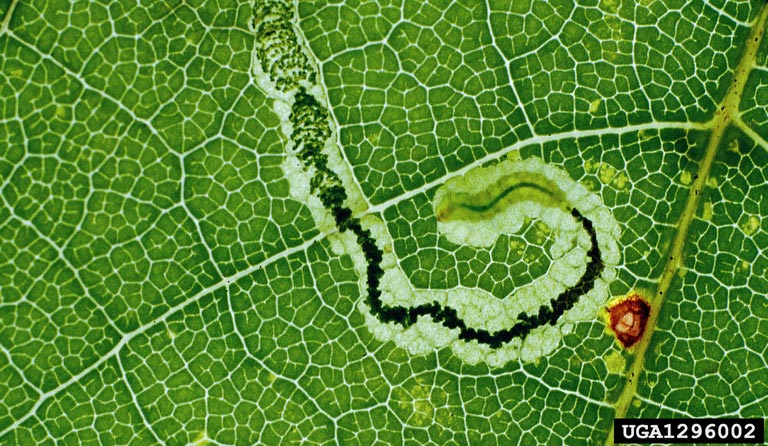 Stigmella aceris (link to image credit)
Stigmella aceris (link to image credit)
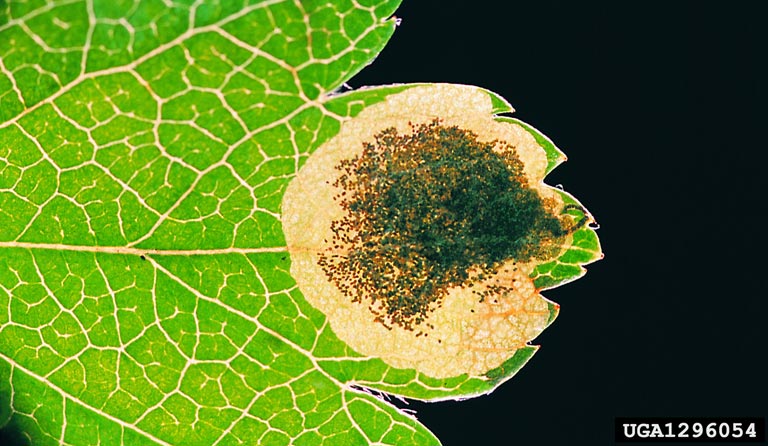 Stigmella paradoxa (link to image credit)
Stigmella paradoxa (link to image credit)
If you look at the above images of mines it’s not all that difficult to imagine structures like this fossilizing. And amazingly, they have! The first image below (Labandeira et al., 1994) shows a variety of leaf mining Nepticulidae mines (and a Gracillariidae) from the mid-Cretaceous (97 juta tahun yang lalu). The spectacular thing about leaf mines is that you can get down to genus level and sometimes even species. The authors were able to differentiate between the nepticulid genera Stigmella dan Ectoedemia based on the patterns preserved in the fossils; patterns we still use to help separate genera today. The bottom illustration is from a mine discovered in Japan that is only around 8 million years old (Kuroko, 1987).
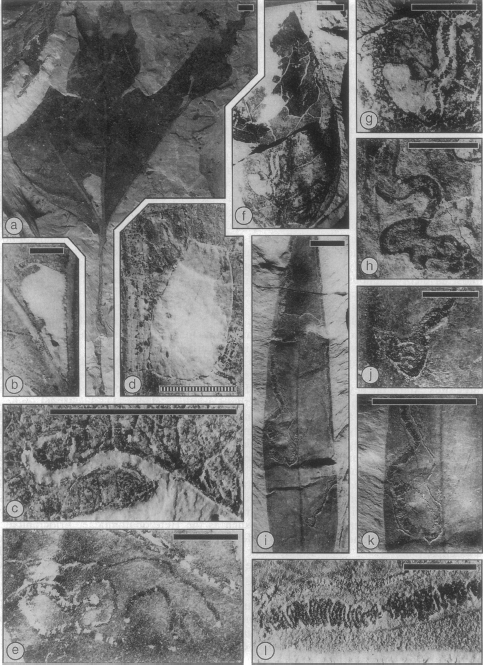 (Labanderia, 1994)
(Labanderia, 1994)
References
Kuroko, H. (1987). A Fossil Leaf Mine of Nepticulidae (Lepidoptera) from Japan. Bulletin Sugadaira Montane Res. Cen., No.8, 119-121.
Labandeira, C. (1994). Ninety-Seven Million Years of Angiosperm-Insect Association: Paleobiological Insights into the Meaning of Coevolution Proceedings of the National Academy of Sciences, 91 (25), 12278-12282 DOI: 10.1073/pnas.91.25.12278
PUPLESIS, R., DIŠKUS, A., ROBINSON, G., & ONORE, G. (2002). A review and checklist of the Neotropical Nepticulidae (Lepidoptera) Bulletin of The Natural History Museum. Entomology Series, 71 (01) DOI: 10.1017/S0968045402000032
Powell, J.A., Opler, P.A. (2010). Rama-rama Amerika Utara Barat – oleh J. A. Powell dan P. A. Opler Entomologi Sistematik, 35 (2), 347-347 DOI: 10.1111/j.1365-3113.2010.00525.x
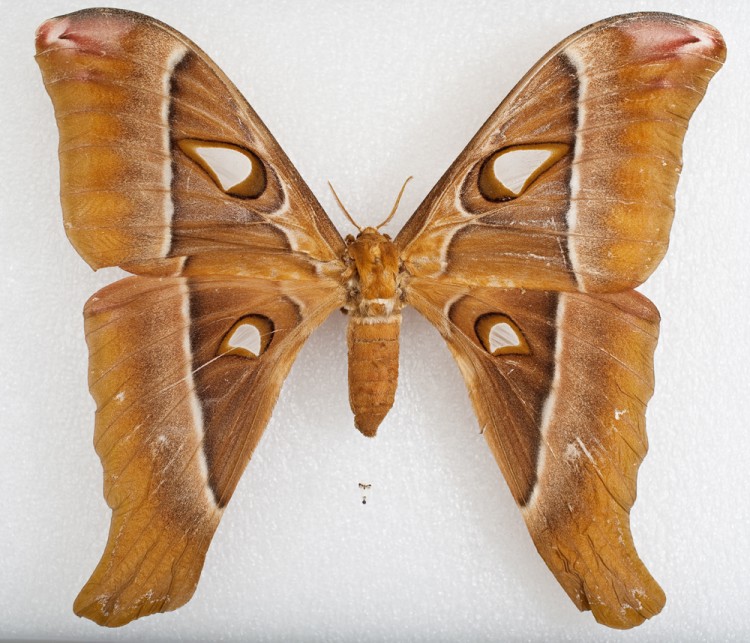

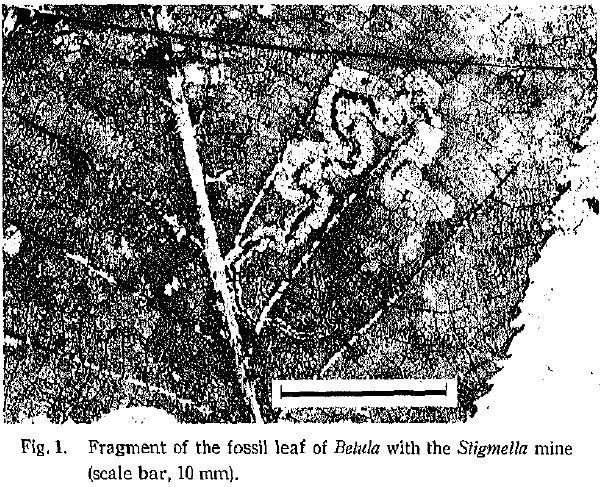

Interesting!
I will give these critters a go when the season starts. As a dipterist specializing in the Psychodidae, the Nepticulids’ size range is slightly above what I am usually working with. I suspect that I can make the transition rather rapidly if I just modify my current methods slightly…
Happy to encourage someone to start working with leps! I think the scales on the microleps are more sensitive than would be on a Psychodidae, but I do know how delicate those wings are on the flies so they might not be that far apart after all.
There are numerous Nepticuliids in Monterey County, California, from the following families (Setakat ini!) Sumac,Barberry,Birch,Pea,Beech,Walnut,
Mallow,Sycamore,Knotweed,Buckthorn,Rose,Willow. Some plants have more than one species. Rosa californica has an Ectoedemia and two Stigmellas. Interesting, pretty moths.
Chris,
I am making a video about microlepidoptera moths for school. I would like to use your picture of the microlepidoptera compared to the huge Coscinocera hercules for a video we are making. May I please use it?
Terima kasih,
Cesar
Pasti, you’re welcome to use the image for school!
Chris,
Thank you for letting us use your picture we will send you the link to the movie when it’s done.
terima kasih,
Cesar
[…] The tiniest of moths […]